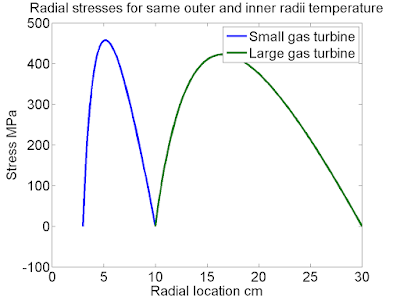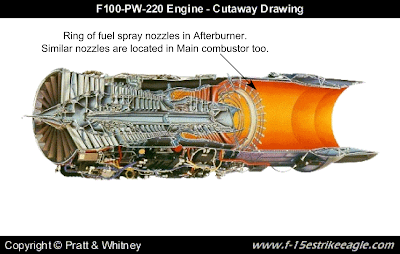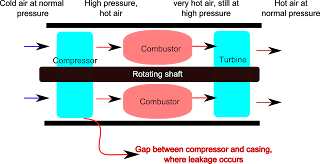Technical challenges of small gas turbines
Part 4
Note: If you are un familiar with the small gas turbines, they are a niche sector of small to medium size jet engines. For an introduction, see this post.
In this post, let us look at the problems faced in the
design of the turbine blades and turbine disk of the small gas turbines.
The turbine blades, have to face the hot gases coming from
the combustor. The material in which these blades are made determines the TET
(Turbine entry temperature = exit temperature of the gases from the combustor).
Any more hotter, the TET exceeds the material limits of the
turbine blades and the turbine blows up.
And you have to try keep the TET as high as possible so that
you don't lose thermal efficiency.
in a study on methanol fuelled gas turbines, the authors
have published a figure that shows the increase in thermal efficiency as TET increases.
| Increase in thermal efficiency as TET increases, from Asahi-net. |
This desire to push the TET as high as possible has lead to
several advances in turbine blade cooling. One common technique is to use
serpentine flow passages inside the turbine blade. These passages effectively
make the turbine blade hollow. Air ducted from compressor outlet flows through
these hollow blades. The outer skin of the turbine blade faces the hot
combustor exit gases (around 1600 degree Celsius) and the inner skin faces the
relatively cooler gas (around 400 degree Celsius). This cooler gas carries some
of the heat energy from the hot gases and hence keeps the turbine blade
temperature from exceeding its limits.
The problem in implementing these passages in SGT blades is
that the blades are too small. Hence it is difficult to machine such intricate
passages inside the turbine blade. A figure showing a larger engine's turbine
blade and SGT's turbine blade side by side, gives an idea of the level of
intricate machining required in SGT blades.
 | |
|
The next problem is that of thermal stresses in the turbine
disk. As you can see in the image below, the periphery of the turbine disk will be at the temperature of the hot gases. Say 1600 degree celsius. The
hub of the turbine disk, where the shaft attaches to the disk, is at a much
lower temperature, around 300 degree Celsius.
| A turbine disk with blades, from codesmith.com |
This difference in temperature causes thermal stresses. The
difference in temperature is same for both SGT and large engines, but he
distance over which this change in temperature happens is much smaller in a
SGT.
This smaller distance gives higher stresses for the same
temperature change.
Demonstrating with an example:
The formula for radial stress in a disk of uniform thickness
(E = Youngs modulus, α = coefficient of expansion ) is
In the above equation, the constants A and B can be found by
imposing the condition that the radial stress has to be 0 at the inner and
outer radius. Using this equation, the radial stress distribution of two
turbine disks have been computed and plotted below. The temperature at the
inner radius of both the disks is 300 degree Celsius and the temperature at the
outer radius is 1600 degree Celsius. The SGT disk is smaller, with the inner
radius of 3 cm and outer radius of 10 cm. The larger turbine disk has a inner
radius of 10 cm and outer radius of 30 cm. The graph below shows the level of
radial stress along the radius of the turbine disk.






